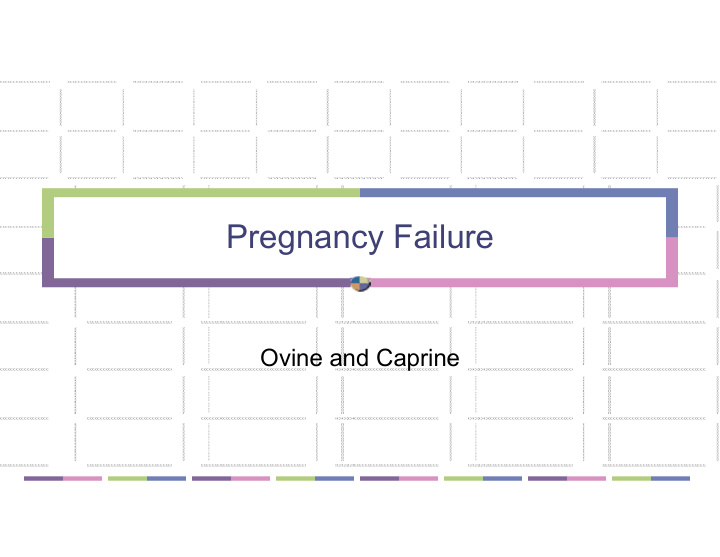



Pregnancy Failure Ovine and Caprine
Small Ruminant Infectious causes are more common in the list of diagnoses CCC and T: Chlamydia, Coxiella , Campylobacter and Toxoplasma Chlamydia and Coxiella are zoonotic.
Ovine Abortion* No Diagnosis 48 Noninfectious 2 Infectious 50 17 Chlamydia abortus 4 Campylobacter 19 Toxoplasma gondii 5 Coxiella burnetii Virus 0 * Animal Health Laboratory, University of Guelph
Goats No diagnosis 52 Noninfectious 4 Infectious 40 13 Coxiella burnetii 9 Chlamydia abortus 9 Toxoplasma gondii Bacteria 3
Goats Coxiella especially important Goats are very susceptible to ‘stress’ and luteolysis
Fetal lesions
Fetal lesions Cyclopia Veratrum californicum (d14) Arthrogryposis* Anencephaly Cache Valley orthobunyavirus Cyclops – greek word Arthros = joint Hepatic necrosis Gryposis = abnormal curvature Regions - Campylobacter An = no C.jejuni, fetus fetus, and fetus venerealis Encephaly – brain Multifocal necrosis – Listeria Photo complements of Pathologic Basis of Veterinary Disease
Fetal lesions Cyclopia Arthrogryposis Cache Valley orthobunyavirus Hepatic necrosis Large multifocal Campylobacter, C.jejuni, fetus fetus, and fetus venerealis. Helicobacter sp Small multifocal Listeria monocytogenes
Iodine deficiency
Placental lesions Chronic placentitis (CCC) Focal necrosis in cotyledon (toxoplasmosis)
Placental Lesions: Chronic placentitis
Pathogenesis of placentitis Exposure of mucous membranes Local proliferation Bacteremia Localise in endometrium/placenta, fetomaternal interface. Trophoblasts around placentome especially infected Logarithmic growth of organism Necrosis, neutrophilic inflammation Failure of pregnancy Incubation Coxiella - Chlamydia – 50-90 days Campylobacter – 7 - 60 days
Chlamydia Herd history - naive herd Incubation = 50-90 days Immunity only when abort First year - replacements abort Next year – storm with up to 75% loss Following year enzootic – ewe lambs
Coxiella burnetii Highly resistant to physical and chemical agents, and has ‘endospores’. Highly infective in dried state – barns persistently infected for years Clinical systemic disease in humans Carrier goats, cattle, sheep, cats, birds and other wildlife Shed in urine, faeces, milk, uterine discharge, but usually in parturient period. Triggers for multiplication and shedding not known.
Placental Lesions: Focal necrosis in cotyledons
Toxoplasma gondii Cat – rodent lifecycle Cat sheds oocyts for 7 days post infection Herbivores infected from contaminated feed – stored and pasture Adults develop immunity Infection during pregnancy Placental and fetal infection Abortion with characteristic lesions, mummification, stillbirth, weak lambs
Toxoplasma gondii Control Control cats and rodents No kittens, have cats use litter Feral cats and contaminated feed problematic
Regionally important diseases
Others Brucella ovis (not zoonotic) Pestivirus D (Border disease virus: related to BVDV) Pestivirus A and Pestivirus B (BVDV ) Schmallenberg orthobunyavirus Iodine deficiency (Great Lakes basin) Wesselbron virus Rift Valley fever phlebovirus (zoonotic) Brucella melitensis (zoonotic - Mediterranean fever)
Recommend
More recommend